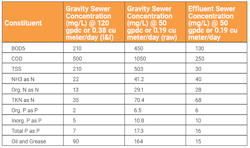About the author:
Tristian Bounds, P.E., is research and development engineer for Orenco Systems Inc. Bounds can be reached at [email protected].
Around the U.S., many state and local regulations require facilities and residences with failing onsite wastewater systems to connect to gravity wastewater collection systems. This typically occurs when onsite systems fall within a jurisdiction’s urban growth boundary or within a specified distance to a gravity sewer. These requirements often impact economic growth and development. They also tend to push developers toward solutions that are not energy-efficient, environmentally friendly
or cost-effective.
Effluent sewer systems can benefit small communities and isolated developments, including reducing up-front capital costs, lowering life-cycle costs, improving system performance at low flows, reducing maintenance, increasing reliability and decreasing operation requirements. These can save utilities thousands of dollars in up-front and life-cycle costs.
With decentralized collection technologies available—such as effluent sewers—communities and utilities should consider implementing impact-fee adjustment for specific users based on organic, hydraulic and operational impacts. With this billing system, those using technologies that reduce the impact on the wastewater collection and treatment system pay lower fees.
Why Effluent Sewers?
Effluent sewers are a type of pressure sewer that have been around for more than 30 years. In an effluent sewer, raw sewage flows from a home or other building to a watertight underground tank, where primary treatment occurs via settling and natural biological processes. Solids remain in the tank, where organic matter is digested over time, decreasing solids volume and reducing biosolids treatment loads, along with associated costs, at secondary treatment facilities. Filtered liquid effluent is discharged by a high-head effluent pump or by gravity through small-diameter service laterals to small-diameter collection lines. These service and collection lines are shallowly buried, typically just below frost depth, and can follow the contour of the land. The on-lot tank serves several physical functions critical to every system:
- It provides sufficient hydraulic retention time for capturing grease, grit and other substances that settle or float.
- It allows sufficient storage capacity for sludge and scum, resulting in long solids retention times and long intervals between septage pump-outs.
- It provides natural digestion, greatly reducing the impact of solids on the treatment facility such as eliminating the need for pre-screening, wastewater comminutors and sedimentation basins.
- It offers enough reserve space for 24 to 48 hours of normal operation before an emergency condition must be corrected, which minimizes the need for immediate or after-hours maintenance.
- It provides an operating zone sufficient for modulating peak inflows without causing nuisance alarms or excessive hydraulic gradients.
- It performs primary treatment so that organic loads on downstream treatment facilities can be greatly reduced, typically by 65% or more relative to other sewer alternatives.
Since solids in an effluent sewer system are collected and digested in the on-lot tank, only liquid effluent is conveyed to the collection system. In addition to removing solids, these tanks provide highly efficient wastewater treatment—more than 45% overall—yielding effluent that is relatively free of fats, oils, greases and other constituents that can clog and foul collection and transport equipment. Transport line cleanings are eliminated as a result, so effluent sewer owners and users should be exempt from the charges typically associated with those cleaning activities. In addition, effluent sewer collection systems are watertight, reducing infiltration costs during conveyance and at the treatment facility. These benefits are important to consider when comparing collection system alternatives.
With effluent sewers, multiple user sites can be connected together in an economical manner. Commercial sites generally have one or more primary tanks followed by a pump tank. Tanks for commercial sites range from a single 1,500-gal (5,678-liter) tank, to several of these tanks in series, to large, poured-in-place tanks.
The tank immediately preceding the pump tank typically is equipped with one or more effluent filters to further reduce solids transfer to the collection system.
Comparing Wastewater Flow Rates
Sample wastewater flow rates for effluent and gravity sewers are provided in Table 1. This information can be used to compare the equivalent dwelling units and system development charges of each collection system to evaluate a fee structure based on proportional wastewater strength and loading rates.
The derivation of wastewater flow rates is founded on typical wastewater flow rates from residential dwelling units. Additionally, the U.S. EPA’s Alternative Wastewater Collection Systems manual states, “At this time, thousands of flow measurements have been made on pressure sewer systems with wide demographic spread. The result of these measurements has corroborated findings of the earlier studies: that due to limited [infiltration and inflow] (I&I) in watertight effluent sewer systems, flows are typically 40 to 60 gal per day (0.15 to 0.22 cu meter/day) per capita, with little weekly or seasonal variation.”
Gravity systems are known to suffer from significant groundwater and storm water I&I. This requires downstream treatment plants to process more water than would ordinarily be generated by normal wastewater activities. I&I also causes greater demand on lift station pumps, larger collection and treatment facility sizing requirements, and higher operation, maintenance and power costs. Typical design average flow values for gravity sewers are 100 to 120 gpd (0.38 to 0.45 cu meter/day) per capita.
Design average flows are defined as 30-day average flows, whereas design maximum day flow is defined as the maximum daily flow to occur over a 7-day period. The 24-hour backup storage in an effluent sewer’s on-lot tanks reduces emergency call frequencies and overtime costs, and it minimizes concerns about untreated sewage overflows.
Wastewater Characteristics & Benefits
Table 2 shows expected constituent concentrations (based on industry standards) from individual residences. Wastewater characteristics in the left-hand column are typical values for systems with significant dilution from I&I. Raw domestic waste strength for gravity sewer systems with zero dilution averages 450 mg/L five-day biological oxygen demand (BOD5) and 503 mg/L total suspended solids (TSS), as shown in the center column.
Several wastewater treatment technologies—lagoons, sequencing batch reactors, moving bed biofilm reactors, conventional activated-sludge, extended aeration, and membrane bioreactors, for instance—easily can be paired with effluent sewers. Due to the reduced organic load and hydraulic load associated with effluent sewer collection, treatment facilities are better sized when compared to those receiving wastewater from a gravity sewer.
The benefits of effluent sewers can be useful not only for new developments, but also for existing communities. Vero Beach, Fla., is one example of a city that chose effluent sewer technology to address issues with the community’s wastewater system. Rob Bolton, the Vero Beach director of water and sewer, evaluated a number of options before choosing an Orenco sewer.
“This effluent sewer collection system provides for a phased build-out and doesn’t require mandatory connections,” Bolton said. “Each on-lot tank sends primary-treated effluent to an existing treatment facility, and solids handling, when necessary, is provided through local companies.”
Graduated Sewer Rates
Impact-fee adjustment commonly is used by cities to ensure that high-strength wastewater producers pay their fair share of wastewater treatment costs. Many cities provide a basis for sewer rates and billing that includes a high-strength rate adjustment for both TSS and BOD levels in excess of “normal” domestic waste levels. Any sewer user discharging wastewater with TSS and BOD concentrations above these levels may be subject to wastewater sampling, testing, surcharge billing or even pre-treatment requirements.
On the other side, a fair impact-fee clause should be considered for low-strength wastewater producers to allow for impact adjustments between these users and the local utility. The lower organic load of effluent sewers and their near elimination of I&I can permit bioreactors up to approximately 57% smaller, reduce bioreactor aeration requirements to lower bioprocess aeration by approximately 57%, and reduce biosolids management demands by up to 75%.
Effluent sewers remove the demand for comminutors, grit chambers and primary clarification at the treatment facilities, and can eliminate up to a third of preliminary treatment needs. Long-term costs associated with operating and maintaining these preliminary treatment systems also can be avoided.
A mobile home park project in Prineville, Ore., illustrates how impact-fee adjustments can be implemented. The property was brought into the town’s urban growth boundary, and in Oregon, this requires that it be connected to the municipal system. When its drainfield failed, the park owners knew that a traditional lift station was not feasible, so they evaluated an effluent sewer system. They determined that this option would be less costly up front and would reduce the long-term operational costs of both the collection and treatment systems. Their proposal was adopted by the city council.
Due to extenuating circumstances, connection fees were waived, and rates were adjusted based on the waste strength percentage of primary-treated effluent versus raw wastewater. Incentivizing users to adopt economic low-strength alternatives through fair impact-fee adjustments can benefit the user and the utility by reducing the impacts at the treatment facility and throughout the collection system.
Conclusion
Effluent sewer collection technology reduces waste strength and hydraulic loads in a manner that is energy-conscious, environmentally sustainable and cost-efficient. Based on the tables above, an effluent sewer reduces hydraulic load by 45%, organic load by 62%, and suspended solids load by 85%. Effluent sewers also allow for a reduction in biosolids handling costs and eliminate sewer line cleaning.
By implementing effluent sewer collection, benefits to a utility’s bottom line will be realized through a reduction in solids management, reduced I&I, a lower organic load at the treatment facility, simplified operations and lower operational costs. It is important that developers, municipalities and utilities consider an alternative impact-fee structure for low-strength wastes, which could reduce system development charges (such as initial hook-up fees) and monthly service fees.


